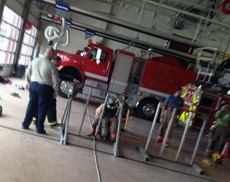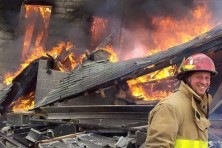Firefighter In Training
- Share
- Tweet
- Pin
- Share

This drill involves following the rope, fitting through the fake wall, grabbing a fake victim, dragging them back along the rope, through the fake wall, and under the truck. While blindfolded. Photo by Matt Ledger
For about the past month, I’ve been training to be a volunteer firefighter. To say it’s been a learning experience would be putting it mildly.
For those who don’t know much about me, here are a few necessary background facts. I have no previous firefighting experience. I have no sort of “emergency response” experience, period. I’m not great with using tools and, while I’m pretty fit, I’m not a bodybuilder or a long-distance runner.
So taking all of this stuff in three or six hours at a time has definitely been work for me. There’s a lot that goes into learning how to properly fight a fire. It’s about knowing how to use your equipment (and man, is there a lot of equipment), knowing how to follow and give orders, knowing the science behind how fire spreads, and, most importantly, keeping a level head and communicating.
There are nine other fantastic gentlemen currently taking the entry-level class (there used to be nearly 15), and on most of the Saturdays we’ve spent doing practical drills, searching through and spraying water at our practice house in Sister Bay, I feel like they’re all either more experienced than I am or just have it together more than I do.
The guys from Sturgeon Bay have ridden along with their department on a bunch of calls. Some of the guys from Sister Bay seem to have gone into their station more to mess around with their equipment, others have family on the department who have been showing them the ropes.
On one of the last search rotations during a Monday night practical class, I was team leader for a group of three guys. During the search, one of our guys wandered off into another room, simulating a situation where a team member takes a wrong turn in a building. Command sent a search team in to find him, but instead they found myself and the other member of my team, who were busy dragging a victim to safety.
One minor miscommunication later (Them: “Are you the lost one?” What I Heard: “Are you the last ones?”) they’re dragging me out of the building and my partner gets left behind to pull the victim out himself. Meanwhile, our lost guy is still, well, lost.
The mess-up was pretty much all mine, and when I called my girlfriend, Kat, later in the day to tell her what happened, I was pretty down on myself. I wondered if maybe firefighting wasn’t for me.
“What if it had happened in real life?” I asked.
That fear of “What if I just mess the whole thing up?” has been the thing that’s been stopping me from turning on my pager most days since I received it. I don’t want to be in the way; I don’t want to be the person that just makes something go horribly wrong.
Kat, as is usually the case, had the right answer to my question. “Isn’t that what the training’s for?” she asked.
The challenge for me at this point isn’t getting through the class. I know I can do that. It’s coming out the other side with the confidence in myself to keep doing this that’s going to be the tricky part.
But when I think of how much I’ve already improved since the start of the class, when I couldn’t even figure out how to loosen the straps on my air tank, to now, when I’m fairly comfortable heading inside a smoke-filled building (if not leading other people through the smoke-filled building), I know that I can take it all in if I just keep with it.
This weekend, the 10 of us are heading down to the burn tower in Green Bay to string together everything we’ve been doing. It promises to be a fun, informative, and challenging day; I’m really looking forward to it. And recently, I’ve been making a habit of turning my pager on every night after I get home from work. I don’t carry it with me everywhere yet, but I’m working my way up to it.
So, slowly, I’m becoming someone that I wouldn’t mind seeing help out on a fire scene, and you might start seeing me stepping off one of those yellow Baileys Harbor trucks when they pull up to help you out.


